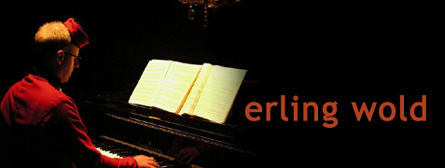 First night of the SF Tape Music Festival tonight. My colleague Thom Blum premiered a fantastically beautiful and nuanced piece, a state of grace. Aaron Ximm, recent father and former director of my favorite concert series in San Francisco, presented a painfully lovely modification of recordings made of Southeast Asian orchestras.
First night of the SF Tape Music Festival tonight. My colleague Thom Blum premiered a fantastically beautiful and nuanced piece, a state of grace. Aaron Ximm, recent father and former director of my favorite concert series in San Francisco, presented a painfully lovely modification of recordings made of Southeast Asian orchestras. Overall, a lovely mix of modern fixed media works and some of the more famous works from the early days of electronic music, many from the first concert of musique concrète - the Concert du Bruits of 1958, my birthyear (and here today is my birthday). Sadly all of the old guard seem to have died in recent years: Pierre Schaeffer, György Ligeti, Vladimir Ussachevsky, but it was surprising to me how similar the old and new pieces were. The rhythms and the range of the sonic variations were quite alike, more amazing given the painstaking methods available in those heady early days: the razors and the tape and the wires and the bouncing and the fiddling with the oscillators, compared with the whiz-bang point and click technologies available to the sound-composer of today.
But what struck me the most was that the aforementioned rhythms, like the rhythms of the classical-to-modern instrumental music that preceded, fell into the range of speech rhythms, nothing happening too slowly or too quickly developing, all of medium tempi. It reminded me of a discussion in Gérard Grisey's composition seminar. It had been noticed that the tempo dimension had been woefully unexplored. But why was it that the European modern music of that time - the mid-80s - was pushing only towards a slower tempo? The harmonic rhythm of his music, like all the spectralists, was by its nature very slow, examining the intra-harmony of all the pitches of a single tone under a time-microscope. Why was no modern music fast? I answered immediately: because that would require a pulse, and pulses had been rejected by the modern musical establishment at the time. It took the music of the minimalists and maximalists and totalists to go back to fast.
When I was writing Little Girl and using bits of pieces of the minimalist language, I noticed the fact - and I wasn't the first, ok? - that passages of eighths could seem much faster than passages of sixteenths, and that the pulse depended on the perceptual rhythmic groupings or perceptual chunks of time. How we perceive these chunks are under the control of any good composer, but these issues stand out very quickly in patterned music, e.g., the Alberti-like arpeggios that attract so many of us. The problem with fast say, totally serialized music, is that without pattern or regular repeated rhythms, even as the notes whiz by ever faster, the brain keeps chunking bigger groups of them to bring the perceived tempo down into familiar territory. It has to be led by the hand into very fast tempi by the use of lots of patterned cues. House music does it, easily hitting 180 bpm, the distinction of genre sometimes falling almost exclusively to the tempo range, but within the limitations of extreme repetition and audiences under the influence of very particular drugs.
And, what is even more interesting about this speeded-up dance music is the concomitantly slow or even nonexistent harmonic rhythm. When writing my orchestral waltzes mentioned in recent posts, I realized that the harmonic rhythm of the famous old 19th century waltzes, e.g. those of the junior Strauss, was much slower than what I typically succumbed to in a waltz feel. Satie-influenced, I've tended to believe in the doctrine of one chord per measure, but that's clearly not the way the Kaiser liked it. But still, the Kaiser and I favor a harmonic rhythm that is within the normal range, that doesn't raise too many skirts up to allow us to see the brutish realities of nature beneath. I remember a composer friend being scolded back in college for too fast of a harmonic rhythm. That struck me strange back then and it still seems odd now. It's easy to make your harmonic rhythm slow - lots of music does that - but it's actually pretty hard to make it fast, and too fast? Well try it - it's not easy. At some point, the brain re-chunks the music to bring it back into the normal range. And, in the tape concert, you could hear an analogous timbral rhythm in all the pieces, old and new, again often falling into the same range.
One technology not so easily available to the old school concrète folks was the multi-speaker spatial diffusion on display, the performance aspect of the fixed media world that also gives us as the audience, sitting in the almost-dark, at least something to watch. The diffusion tended to coerce the primeval recordings into the same sonic world as those more recent. Sometimes, most noticeably for me in the Ussachevsky, it was a bit garish, pushing that piece in particular into a faster spatial rhythm that gave the whole thing a jazzed-up feel. But again, the spatial rhythms never seemed too fast. Even when there was a quick ping-pong-like panning, it was perceived as a gestalt, as a sound with a complex spatial quality, not leading us to tap our toes, not pulling us towards speed and all its dangers.





No comments:
Post a Comment